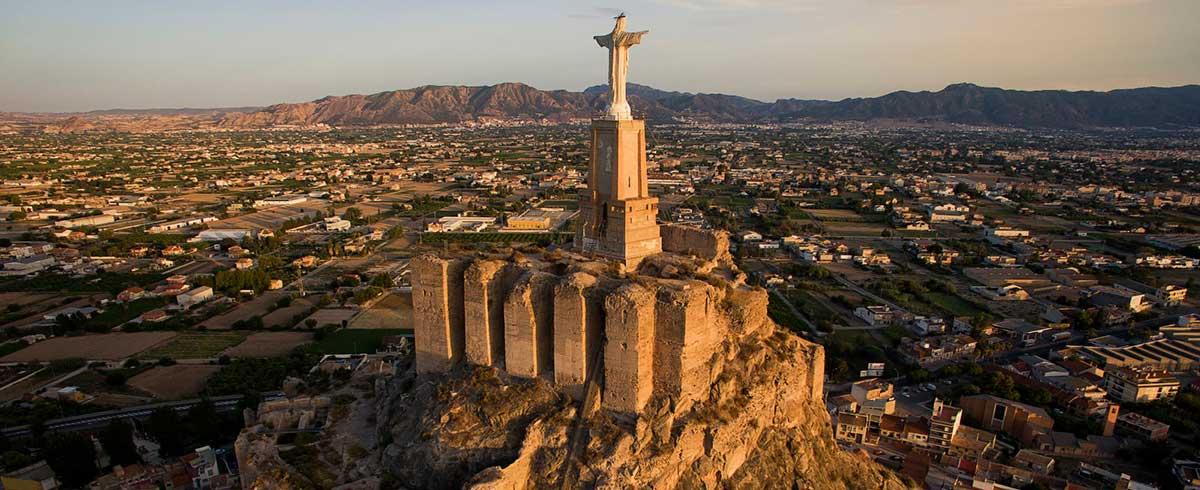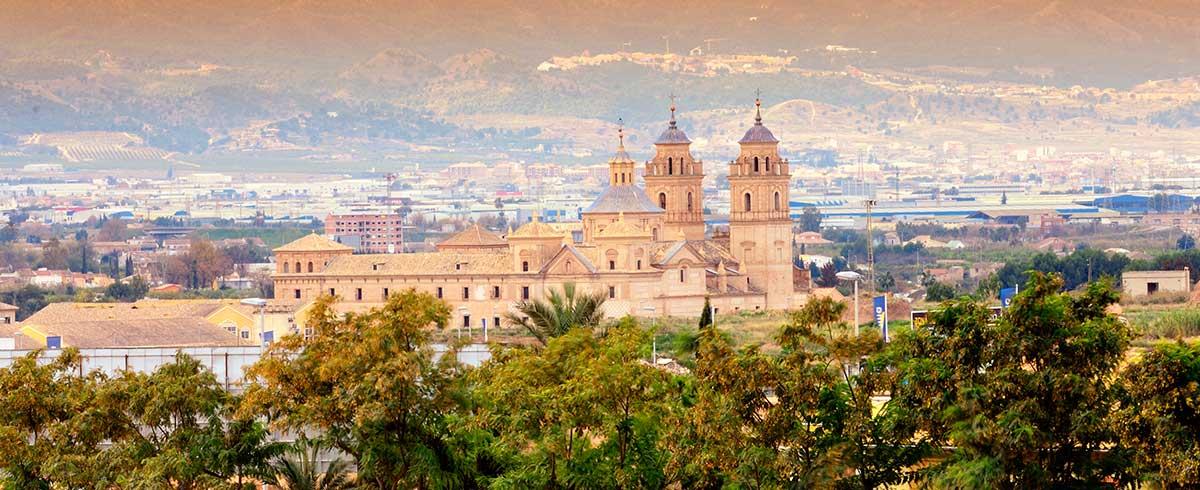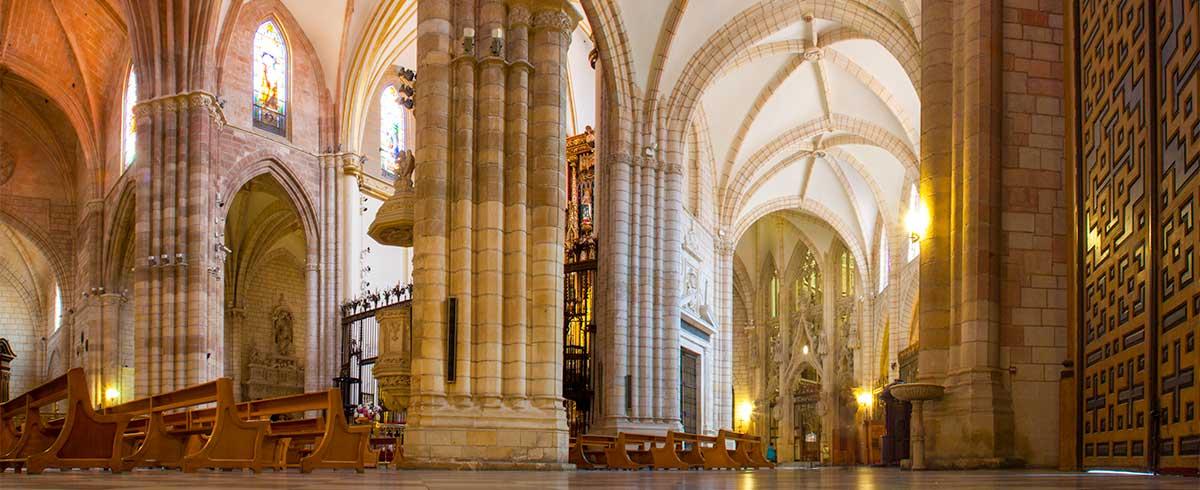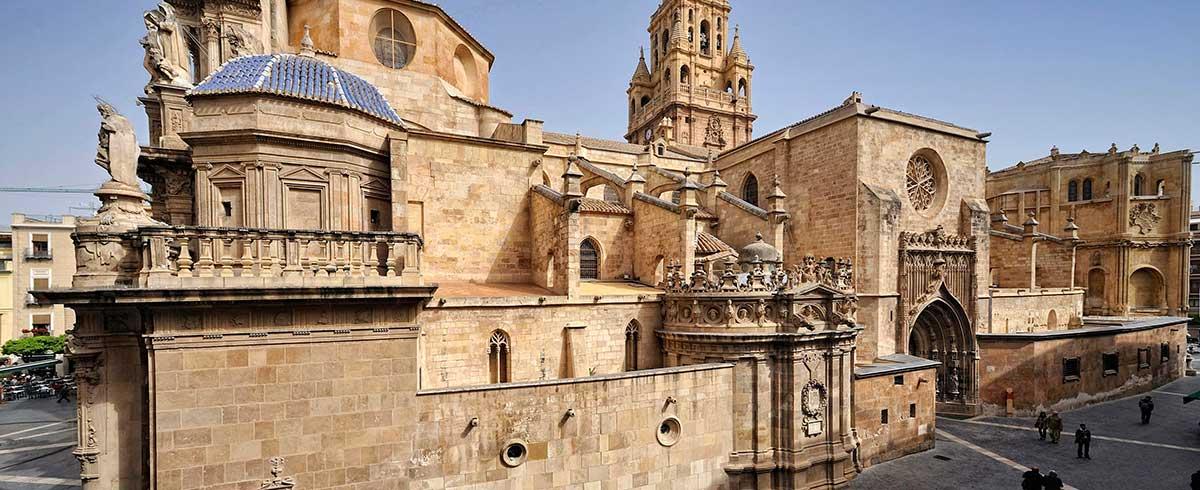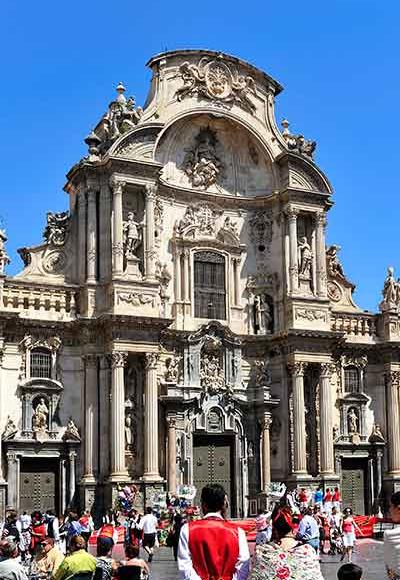
THE CATHEDRAL
The cathedral is the perfect starting point for any tourist route through the city. Artistically speaking it is the city’s most important building, and its tower is the symbol of Murcia. It is also the main church of the Diocese of Cartagena.
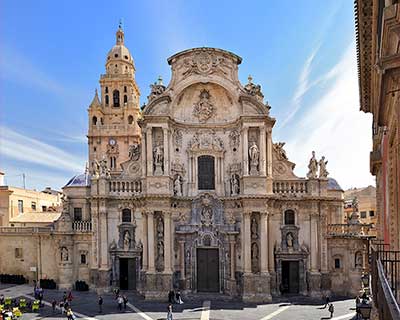
It was built over the course of five centuries (14th - 18th), and its various styles (Gothic, Renaissance and Baroque) are an impressive testimony to the history of Murcia. Construction began on the building in 1385, on the ground that formerly housed the largest mosque in the city.
The bell tower is 90 metres high (95 with the wind vane), making it the second highest in Spain after the Giralda in Seville. It is the highest point of the entire city and is composed of five structures decreasing in width. Each of them shows a different artistic style than the last, making it a must-see for visitors.
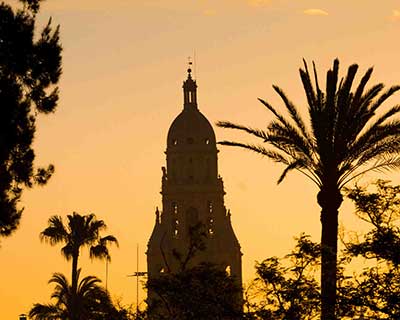
The interior is largely in the Gothic style. It contains three naves with an ambulatory and chapels. Most of these are the tombs of bishops and nobles who supported or participated in its construction. Among the 23 chapels, the Vélez Chapel is of particular interest. With its “Flamígero” Gothic style, an impressive ten pointed star dome and the Chapel of Los Junterones, it is one of the great works of the Spanish Renaissance. Also of note are the Plateresque choir stalls, the retrochoir and the entry to the sacristy.
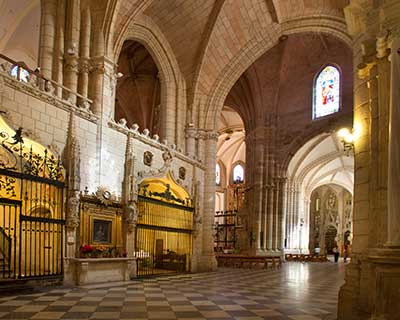
[MAPA-CATEDRAL]
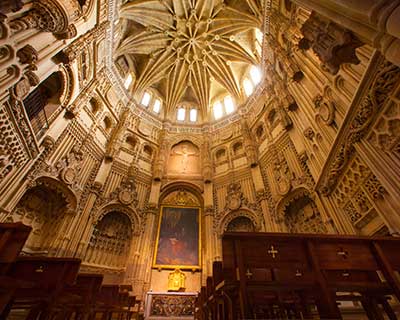
The main altar contains the heart and entrails of Alfonso X, who ordered this in his will as testament to his love for Murcia and the great loyalty the city showed him.
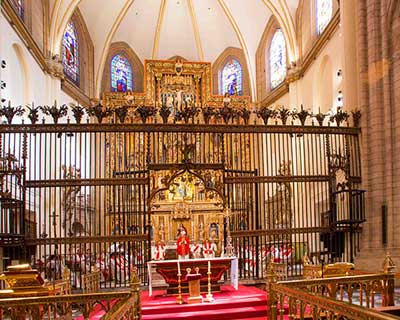
Outside, the cathedral has three points of access:

The Main Façade was created by Jaime Bort. An internationally regarded jewel of the Baroque of exceptional beauty, it is one of a kind. It was created thanks to the help of Cardinal Belluga - a Roman Cardinal and great benefactor of the city - to whom the plaza in which the cathedral stands is dedicated to him, now one of the most important meeting points and event place in Murcian life. The two main themes of the façade are the exaltation of the Virgin Mary - to whom the church is dedicated - and the glorification of the church.
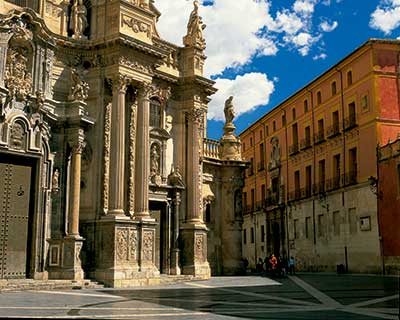
The Door of the Apostles, in Gothic style, takes its name from the sculptures of the four apostles that adorn it.
The Door of the Chains, in Renaissance style, is decorated with reliefs of three of the four Brothers who were patrons of the diocese: San Leandro, San Isidro and San Fulgencio.
Also of note is the exterior of the Chapel of los Vélez, which is surrounded by a spectacular stone chain that has been the subject of several legends throughout history.
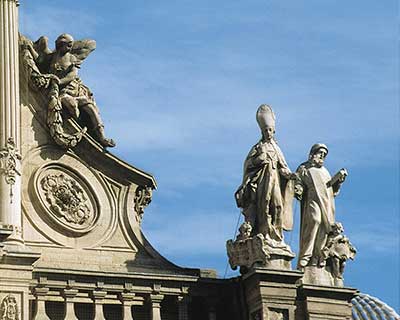
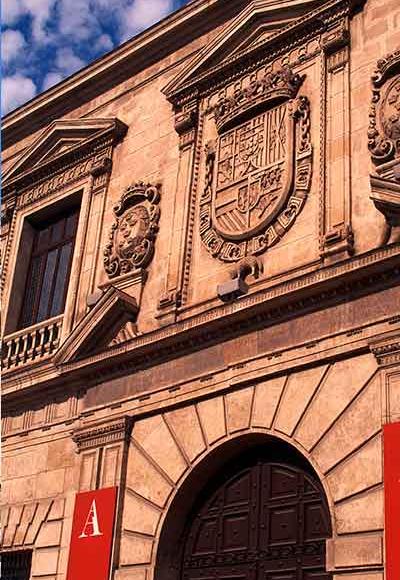
ALMUDÍ PALACE
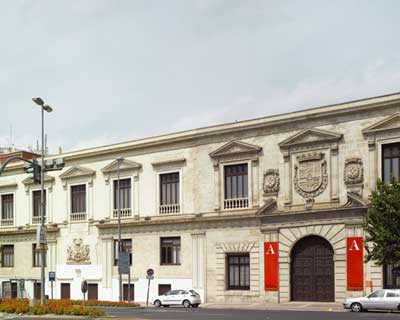
A uniquely imposing building from the 15th century, located in the Plano de San Francisco, its patio of columns transports us back to Baroque Murcia. It was once used as the city’s granary, or alhóndiga. The idea to build a place to store the grain collected as tithes is attributed to King Alfonso X the Wise in the 13th century..
Work on the building, overseen by Esteban Fernández, was completed in 1440. Later, in the 16th century, it underwent a series of remodellings. In the 17th century several of its buildings were temporarily used to store weapons while the “Contraste” building was under construction. In 1612 a lightning strike hit the munitions storage, destroying much of the building.
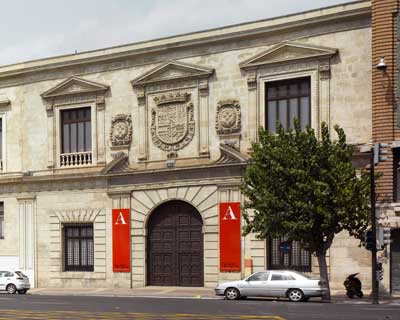
In 1886 the building became the Law Court, and today it houses the City Archives, located on the first floor, containing administrative documentation of Murcia and the Huerta from the 13th century onwards. It is also an art centre, with the Tuscan column room used for exhibitions.
The main door of the building is crowned by a huge royal coat of arms of the Hapsburgs, flanked by two smaller Murcian coats of arms. These coats of arms have only 6 crowns, as they pre-date the reign of Felipe V, the monarch who gave the seventh crown to the city of Murcia.
On the façade you can see the relief medallion of the Matron of Murcia or the Pósito del Pan (Bread Stores), by Hernando de Torquemada. It shows a woman - Murcia - breastfeeding a child by her side, a symbol of the hospitality of Murcians. The relief is crowned by a pelican, a symbol of abundance.

The Almudí was the place for the buying and selling of wheat and other grains. Since wheat has always been the bedrock of food for the people, and there were frequent years of famine and starvation, the public authorities decided to build grain warehouses to meet the population’s needs of both food and seeds.
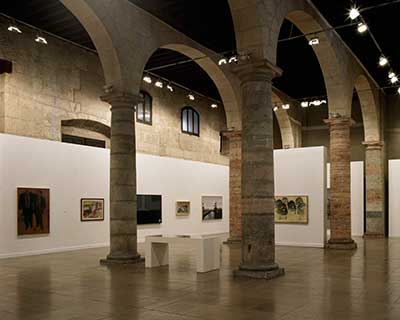
The name Almudí comes from the measurement of grain, the equivalent of six “cahíces” or four thousand litres. Harvesters and merchants came here to trade. The town council also distributed wheat to the bakers.
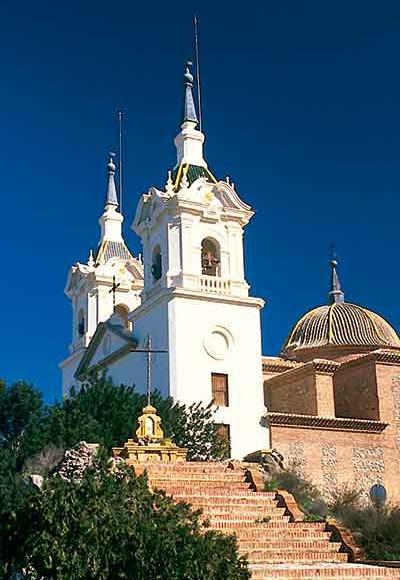
SANCTUARY OF THE VIRGIN OF LA FUENSANTA
Very close to Murcia, in Algezares, is the Sanctuary of the Virgin of “La Fuensanta”, the residence of the patron Virgin of the city. There are pilgrimages to her from the city twice a year (Lent and the September festivals). Worship of the Virgin of “La Fuensanta” - replacing the worship of the virgin of “La Arrixaca” - dates back to the Middle Ages, when the hermits drank the water of a holy fountain (Fuente Santa). The sanctuary, as it is known today, was built at the end of the 17th century, and has since undergone various restorations.
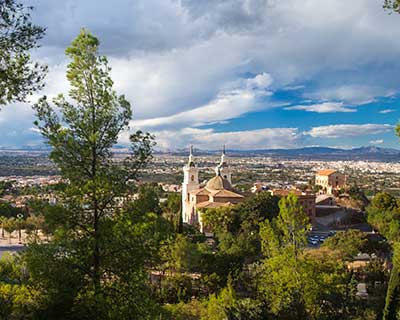
This is a traditional Murcian Baroque church, made up of three naves; a wider central nave and two side chapels. The façade (1705), created by Toribio Martinez de la Vega, has two towers and an arched door. Of particular interest are the two angels holding the coat of arms of the Cathedral Council, through whom the building of the church was made possible, and the central niche with the image of the Virgin of “La Fuensanta” flanked by San Patricio and San Fulgencio, created by Jaime Bort.
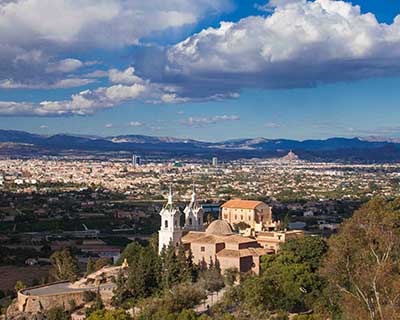
The interior contains some splendid reliefs and sculptures by González Moreno. The paintings and murals of the dome and of the choir are the work of painter Pedro Flores. The first depicts the people and the history of Murcia on a pilgrimage to the Virgin, with Alfonso X, the Count of Floridablanca, Cardinal Belluga, Francisco Salzillo and other illustrious figures from the history of Murcia. In the choir, the painting depicts the coronation of the Virgin of la Fuensanta at the Old Bridge.
The image of the Virgin of la Fuensanta was one of various existing images, and knowledge of it dates back to the 15th century, celebrating her worship during the Incarnation and Nativity. In the late 17th century there was a major drought and many worshippers came to pray to the Virgin. After their pilgrimage to the temple the drought ended. Similar feats occurred many times, so in the mid-18th century the Virgin of la Fuensanta became the patron saint of the city, making the new church even more important.
Next to the Sanctuary are the Hermitage and the Monastery of La Luz (whose first settlers were anchorites), the Hermitage of San Antonio the Poor and the Franciscan Convent of Santa Catalina del Monte, all places well worth a visit.
Mass times (from September 16):
Monday - Saturday: 5:00 pm
Sundays and public holidays:
10: 00h, 12: 30h and 17: 00h.
Monday to Sunday: 9:00 a.m. to 1:00 p.m. and 4:00 p.m. to 7:00 p.m. Schedules mass summer (1 July to 15 September:
Monday - Friday: 9:00 a.m., Saturday: 7:00 p.m.,
Sundays and public holidays: 11:00 a.m. and 7:00
Contact the sacristan beforehand.
ONLY SATURDAY, SUNDAY and FESTIVALS.
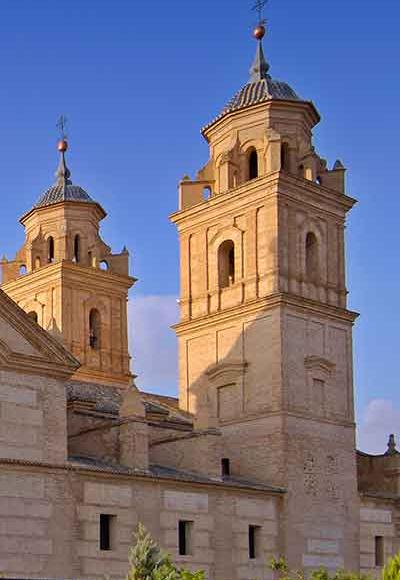
MONASTERY OF LOS JERÓNIMOS
Just a few kilometres from the city centre, in the middle of the “Huerta”, part of Guadalupe, is the Monastery of “Los Jerónimos”, a convent building belonging to the order of the same name, which can also be found in Madrid.
This monastery came from another which was founded in 1579 a nearby area known as Ñora de Abajo, in the modern day district of La Ñora; for that reason, the monastic chapters of the founding orders named it the monastery of San Pedro de la Ñora, a name retained for the new building, though this name fell into disuse after the secularisation of the Hieronymite or jerónima order in 1835, known since then as the Monastery of los Jerónimos.
It was built at the beginning of the 18th century on the orders of the Jerónimos monks, who were looking for an area of the Huerta safe from floods, under direction of the Order’s architect and monk, Antonio de San José. Declared a National Historical Monument, it has been dubbed “the Murcian El Escorial”, and is a work of great proportions. With a Latin cross floor plan, it has a brick façade, a door with a semi-circular arch and two slender towers crowned with domes of vitrified tile in the characteristic blue of Murcia, the same colour as the large polygonal dome of the transept.
The interior is richly decorated with white geometric plaster on a blue background. Of particular note is the baroque altarpiece in marble, alabaster and golden wood. The altarpiece can be dated back to around 1780. This is from a transitional period between baroque and formal classicism, though it has lost some of the original elements and is modelled after the façade of the Cathedral of Murcia.
The monastery has encountered various problems throughout history, particularly as a result of the ecclesiastical confiscations of Mendizábal, which led to the abandonment and looting of the building. It was later given to the Jesuits. In the Civil War, it was used as the aviation barracks. The altarpiece, choir stalls, the masonry and all the images disappeared, apart from that of San Jerónimo, to whom the church is dedicated. It is one of the finest works of sculptor Francisco Salzillo, and is now housed in the cathedral museum.
Today, after several restorations and refurbishments, the monastery is now the headquarters of the Catholic University of San Antonio, making it one of the cultural focal points of the region.
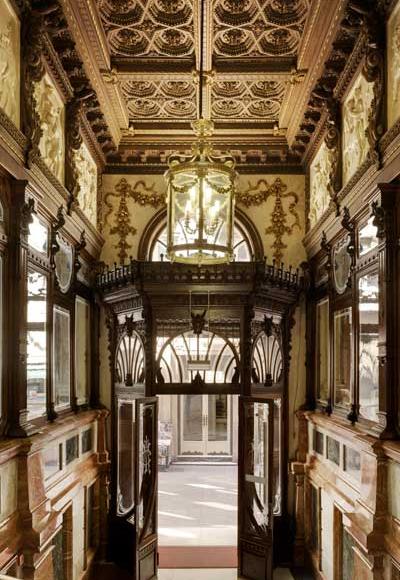
THE REAL CASINO
This architecturally unique building is an iconic spot in Murcia, an emblem of the city. Built in the late 19th century, it contains many different styles.
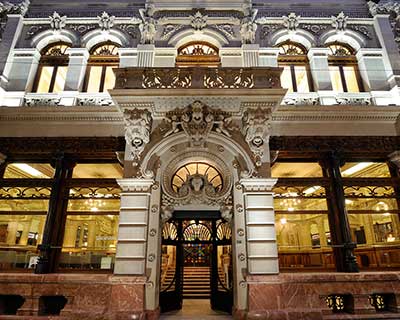
Located in one of the major streets of the pedestrianised city centre - Trapería - visitors are surprised by its eclecticism. For example, the façade is the work of architect Pedro Cerdán Martínez, and contains both classical and modernist decorative elements.
Upon entering, visitors find a Moorish patio built on two levels, topped by a great iron and glass dome. Richly decorated, it is inspired by the royal halls of the Alhambra and the Alcázar of Seville.
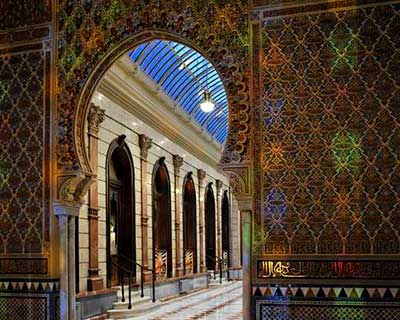
From the patio you can access the gallery, an enormous covered passage serving as a private street. It is used to access the different areas of the Casino, as well as being used as a meeting place. The other rooms on the ground floor are arranged on either side of this gallery.
The “Congresillo” is the popular name of an indoor lounge, which was a meeting place for influential figures within the financial and social life of Murcia, who had a significant influence on the appointment of politicians and other important decisions.
The Pompeian patio, decorated with a beautiful female statue by sculptor José Planes, has 14 columns - made from a single piece, with ionic capitals - creating a wonderful overall artistic effect.
The Ballroom is perhaps the best known room of the building, a splendid testament to the social life of Murcia for over a century. It was designed by the famous architect José Ramón Berenguer, in neo-baroque style. The valuable paintings that adorn the room - four women in the clouds - represent Music, Sculpture, Painting and Architecture. Four medallions represent the famous sons of Murcia: Romea, Salzillo, Floridablanca and Villacís.
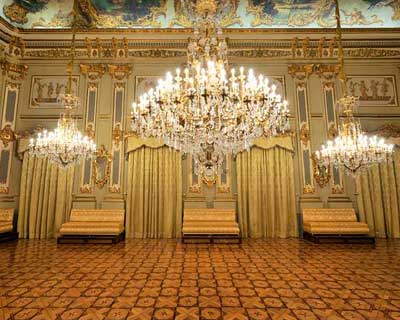
Also of note is the Ladies Powder Room, not just for its luxurious style, but also for the fresco that decorates the ceiling. By painter Marin Baldo, it shows an allegory of the night represented by the goddess Selene. The eyes of the winged woman falling engulfed in flames have become famous for the optical allusion, as they seem to follow you from any part of the room.
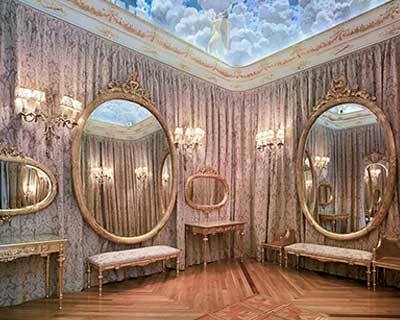
Also of note are the Library, the Billiards room, and two drawing rooms with huge windows looking out onto Calle Trapería, which Murcians, with their characteristic wit, nicknamed the Goldfish Bowls.
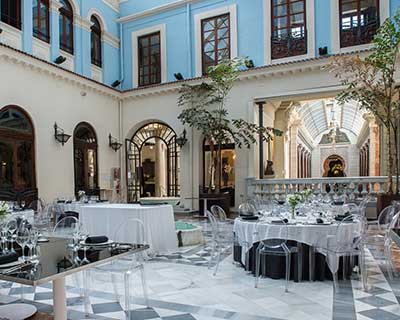
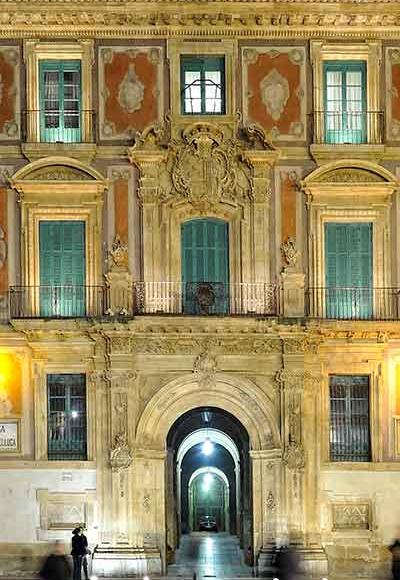
BISHOP’S PALACE
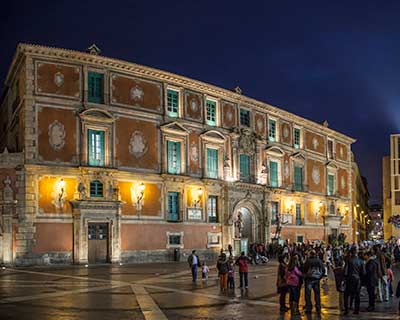
In the Plaza del Cardenal Belluga, next to the magnificent façade of the Cathedral, stands the Bishop’s Palace. It is said that when Bishop Mateo decided to construct a residence from which he could view the newly finished façade of the Cathedral, he ordered this square-shaped palace. The official seat of the Diocese of Cartagena, it was constructed in the 18th century, and today is one of the most important buildings of the city of Murcia’s monumental heritage.
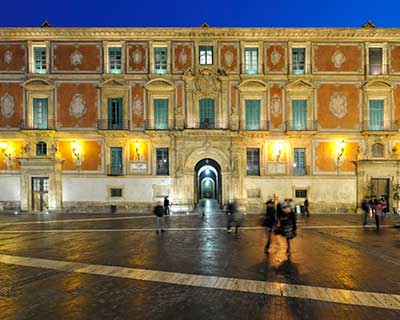
The original Episcopal Palace of Murcia was, until the mid-18th century, on the opposite side of the current Plaza Belluga. That early Renaissance palace occupied a great part of what is today the plaza, built as a part of the urban redevelopment of the area surrounding the Cathedral after the construction of the façade.
Once the old palace was knocked down, a new one was intended to be built in the spot that until then was occupied by the Adelantado Mayor (Military General) of the Kingdom of Murcia.
Made up of unique architectural elements, it is another of the masterpieces of Murcian monumental heritage. Several different masters of stone masonry from other cathedrals collaborated in its construction. It is made up of two interconnected buildings:
The so-called Martillo of the palace (the bishop’s lookout); a part of the building which juts out from the rest, built before the construction of the main building had begun, providing a viewpoint over the River Segura and the Paseo del Arenal, or Glorieta.
The construction of the palace in the mid 18th century, together with other buildings and public works, highlight the importance of the urban transformation that took place in Murcia in that century.
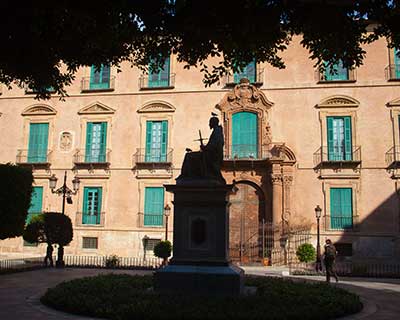
The main building, or the palace itself; built with clear influence from late Italian Mannerism, which is why it is associated with Roman palaces.
The balcony doors of the façade are architectural solutions that can be traced back to those conceived by Michelangelo for the Farnese Palace of Rome in the year 1546. The murals, consisting of fresco decorations, are another characteristic feature of Roman and Neapolitan palaces.
The interior is of great interest: the imperial staircase, particularly characteristic of Roman baroque; the patio, organised in three Dorian arcades and with a more compact upper section; and the small, circular Bishop’s chapel. The shield that presides over the main balcony of the palace commemorates Bishop Roja, under whose mandate the work was completed in 1786.
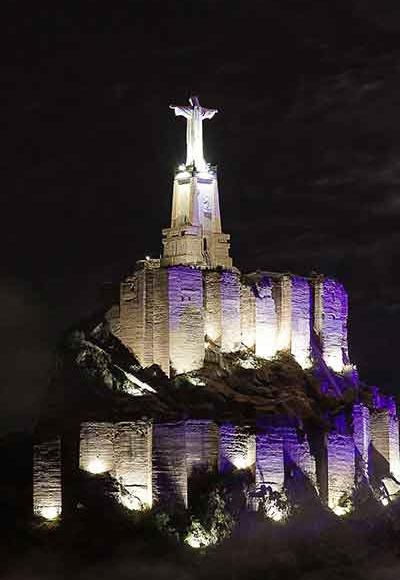
MONTEAGUDO CASTLE
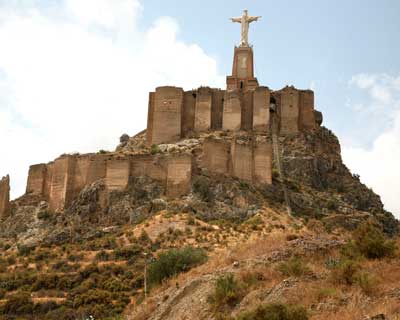
Monteagudo Castle is located at the top of a limestone rock hill, from which it overlooks the whole of the northern valley of the Huerta. On its hillsides sits the town of Monteagudo, some five kilometres from the city of Murcia.
Given its military nature, its location is due to strategic reasons. As the name suggests, (Monte-agut), the fortification occupies a very abrupt massif with a height of 149m and it spreads over two platforms with a diameter of 400m. At its base runs the “Camino Viejo de Monteagudo” (old Monteagudo road) that connects two important routes from the city: the roads to Alicante and to Castile.
This is why the settlement appears to have had such a long and uninterrupted history: Argaric culture, Iberians, Romans and Arabs.
The architectural remains that have been found are the result of numerous restorations and occupations that can be traced back to the Islamic period. Before the founding of Murcia, it was likely a rural castle where local peasants took refuge. When the city became the true capital of the territory, “Hisn Montagut” became an urban castle, a true fort and defensive watchtower of the Murcian emirs who resided in the city and in Royal Almunia, of which the castle forms a part.
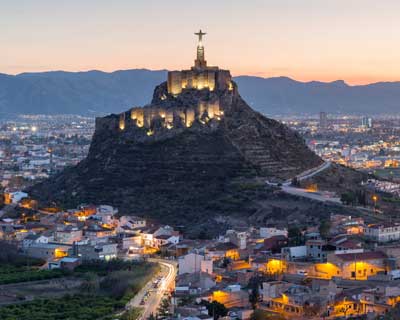
With regard to its technical construction, the Muslim Alarifes built solid mud walls of mortar, marked out with slightly jutting-out rectangular towers situated very close together, acting as true buttresses. The lower area is accessed on the southern side via a dirt road and some rather difficult stairs. Throughout this area, leading to the north-eastern side, you can see evidence of large dungeons, granaries, and other rooms. Access is via a staircase and an interesting bent gateway, carved with a pick and chisel. This was a heavily fortified Alcabaza, with a much more regular floor forming a 50 x 25 m rectangle.
After the Christian conquest, the castle would not lose its strategic nature, coming under the control of the Castilian monarchy. We know that it was visited on at least two occasions by Alfonso X the Wise, and a number of royal “alcaides” or castle guards have lived there. This continued until the latter years of the 15th century, when the Catholic Kings conquered the Muslim kingdom of Granada.
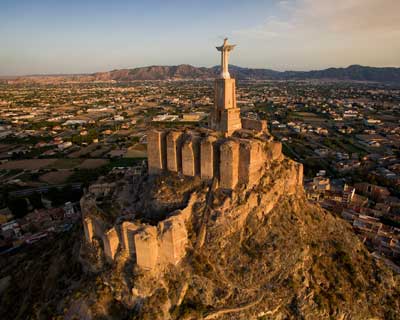
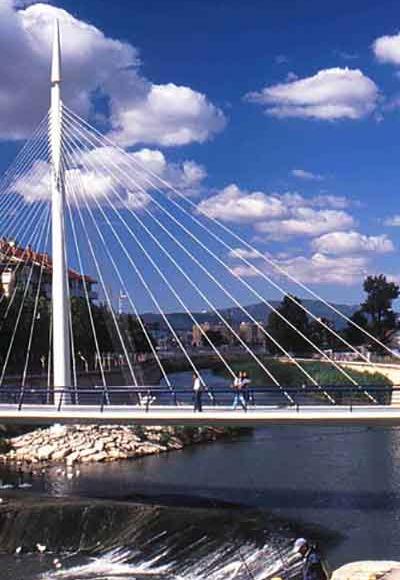
EL MALECÓN ESPLANADE
El Malecón is an embankment wall to protect against the flow of the river Segura. It dates back to 1420 when, following two major floods, the City Council decided to demolish the old and damaged houses in the neighbourhood of la Arrixaca in order to build a wall, which was built on the same boundaries of the current esplanade.
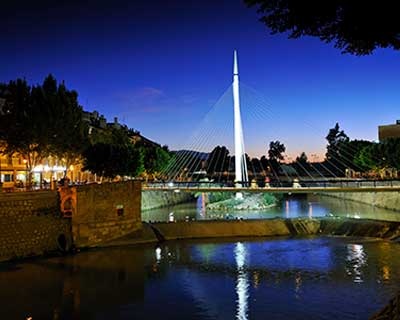
Despite being subjected to numerous repairs, by the 18th century it had heavily deteriorated as a result of rain, wind, horses and the continuous traffic of the city. In 1736, chief magistrate of the city D. Francisco de Luján y Arce ordered its rebuilding. From 1745, following the intervention of Cardinal Belluga, it was rebuilt completely, taking the form that we know today.
Today it is an exceptional esplanade around three metres above ground level. Stretching more than 1,500 metres into the Huerta like a stone tongue wrapped around the west side of the city, running between the gardens of the former Convent of San Francisco and the Botanical Gardens. It is the perfect spot for relaxing or walking, from which you can enjoy magnificent views. There are a number of stone benches to rest on along its entire length.
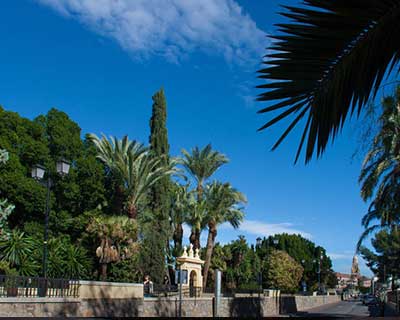
Particularly noteworthy is the arch dedicated to Mary, the statue of the Murcian philanthropist D. José María Muñoz, and the old doorways to the gardens and houses that flanked the Malecón.
On its left side are the Maristas School and the convent of the Capuchinas.
On the right side is the Botanical Garden, created by joining the land of the former garden with other neighbouring gardens, such as the Cypress Garden or the Bombas Garden, with a beautiful baroque entrance that still stands today. Today it is the largest park in Murcia, and since it was first intended as a botanical garden, the name by which it was known to many citizens has been restored. Originally belonging to a Provincial School, created for the students’ studies, what remains of that garden as some of the most remarkable trees that are still standing.
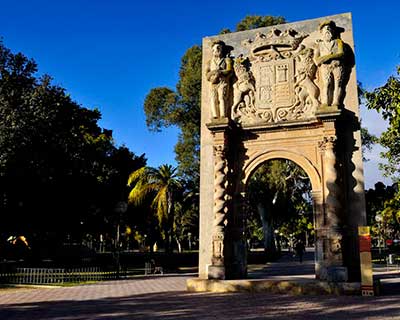
Also on the right side of the Malecón are buildings constructed many years ago, such as the large mansion with lookouts and balconies, which was home to the Murcian poet Pedro Jara Carrillo.
Paseo del Malecón
Paseo del Malecón
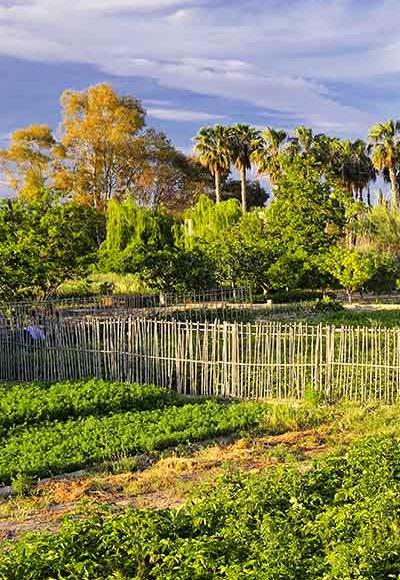
THE HUERTA
Occupying the sloping plains between two parallel mountain ranges through which the river Segura runs towards the sea.
Stretching out throughout the Vega Media area of the River Segura, it is a valley that, throughout the Quaternary Period, the river has left in its course fertile ground for farming. The contributions of the Guadalentín river, which flows into the Segura running downstream to the city of Murcia, has also led to the formation of the Huerta. The first prehistoric inhabitants did not inhabit the bottom of the valley, as the land was swampy, with a high risk of flooding. Argaric remains have been found in the foothills of the mountains bordering the valley of the Segura.
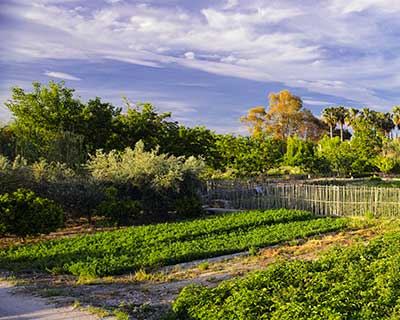
Though the Romans first began cultivating the Huerta of Murcia, it was the Muslims who dried the wetlands and created a highly efficient irrigation and drainage system from the Contraparada weir. The first stop for anyone wanting to learn about the Huerta of Murcia, it is the starting point of a clever system that takes advantage of the water. It allows the water to enter the Vega, so that, via the many irrigation channels which branch out, it can reach the furthest point of both sides of the river, encouraging for centuries the cultivation of fruit trees, especially citrus fruits, and vegetables.
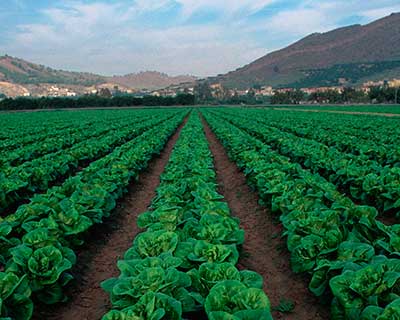
With the Reconquest of Murcia by Alfonso X the Wise, many Muslims fled to Granada and vast areas of the Huerta were uninhabited. Alfonso X shared out among Christians small plots of the Huerta, from which came smallholdings.
At the end of the Reconquest, in the 16th century, there was significant agricultural development with the introduction of the orange tree and mulberry tree, forming the basis of the silk industry. In this century important water-based improvements were made, such as the construction of the Malecón, the elimination of some meanders of the river, the channelling of some sections and canals, and the construction of waterwheels, which raised the water to higher terrains for irrigation.
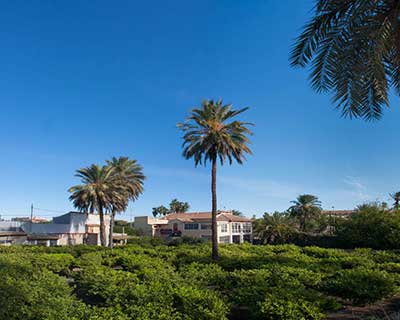
The dominant position which Murcia held in silk production and commerce was contributed to by the fact that the mulberry tree was virtually the only tree grown, as the Huerta provided optimum conditions.
The Huerta of Murcia is also synonymous with fiestas, folklore and gastronomy, celebrated each year with the popular celebrations and parades of the Bando.

